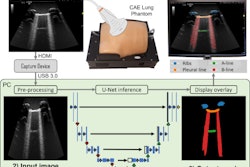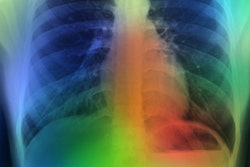
Bedside lung ultrasound can determine whether or not COVID-19 patients need admission to intensive care units (ICUs), according to research from Brazil published May 3 in Ultrasound in Medicine and Biology.
A study led by Cecilia Ravetti, PhD, from the Federal University of Minas Gerais found that bedside lung ultrasound scores measured at different time points of follow-up were higher in COVID-19 patients who required ICU admission and died during hospitalization than patients who were admitted into the standard care ward.
COVID-19 can cause numerous lung complications in patients, such as pneumonia and acute respiratory distress syndrome. Minimally invasive methods to determine the severity of the illness are needed. However, transporting critically ill patients to the radiology department for chest imaging can be clinically dangerous and is associated with a higher risk of spreading the coronavirus.
Previous studies have suggested that bedside lung ultrasound is useful in evaluating COVID-19 patients.
"As it is noninvasive and without ionizing radiation exposure, it is an excellent alternative to other methods for diagnosing and monitoring the pulmonary conditions of patients with suspected or confirmed COVID-19," Ravetti and colleagues wrote. "Moreover, lung ultrasound might reduce the need for patient transport and its related risks."
The team's study aimed to describe the characteristics of sequential lung ultrasound and to test the prognostic usefulness of this exam in a group of patients admitted with COVID-19.
For the study, 66 patients in Brazil confirmed to have COVID-19 were evaluated between April and August 2020, 42 of them in ICU and 24 in the standard care ward. Bedside lung ultrasound exams were performed at three-times points: inclusion, after 48 hours, and on the seventh day of follow-up. Patients ranged in age from 46.7 to 72, and 36 were male.
The lung ultrasound scoring method used ranged from 0 to 26, with higher scores meaning greater loss of aeration.
| Average lung ultrasound scores for ICU patients vs. ward patients | ||
| Standard care ward | ICU | |
| Inclusion | 10 | 16 |
| After 48 hours | 12.5 | 15.5 |
| Seventh day of follow-up | 7 | 16 |
ICU patients also spent more time in the hospital than patients admitted in the ward, the authors noted.
The team further compared the tendency of lung ultrasound scores measured on days one, three, and seven of follow-up between patients who initially required ICU and those admitted to the ward. However, no significant differences were found.
One study limitation was that the team used a phased-array probe to scan the lungs as recommended for some experts in critically ill patients, and a linear probe was used only in situations when barotrauma or pneumothorax was a concern.
"We hypothesized that in times of COVID-19 pandemic when health professionals' exposure has to be limited, this approach could have underestimated the severity, despite our results proving to be different between the groups," the group wrote.



















